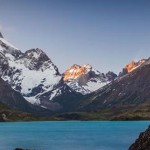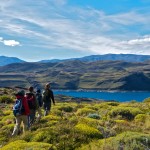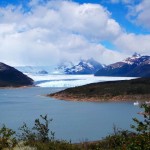
A common question at the early stages of planning a trip to this far-flung and stunning region of the world is “What’s the best way to get down to Patagonia, South America?” The answer of course is by flying, however there are different routes, airports of access, land transfer logistics, and timing considerations to take into account to assure your travels are as smooth, efficient, and cost effective as possible. Patagonia, or the southernmost region of South America, spans both Chile and Argentina and is accessed via either countries capital city.
Accessing Patagonia via Chile



Chilean Patagonia is generally lusher then its Argentine counterpart, lying on the windward side of the Andes Mountains. It is home to what is arguably the crown jewel of Patagonia, Torres del Paine National Park, where you will find vast hiking networks and some of the best Patagonia lodges such as Explora, Awasi, and Tierra Patagonia. Chilean Patagonia can be accessed via Chile or Argentina.
If you would like to get to Torres del Paine via Chile coming from the United States, you will fly to Santiago, Chile’s capital city (airport code SCL). Hubs to Chile in the U.S. are primarily from Atlanta (Delta), Dallas/Ft Worth (American), Miami (United and American), Los Angeles (multiple carriers) and New York (LAN airlines and multiple U.S. based carriers). The flight to Santiago from the United States averages 8-9 hours. Nearly all of these flights will depart in the evening flying overnight and arriving in Santiago the following morning. No or very little time change means, if you can sleep during your flight, you will not experience any jet-lag issues.
To get to Patagonia from Santiago you will fly to Punta Arenas (airport code PUQ). It is generally best not to book your flight from Santiago to Punta Arenas on the same day you arrive in Santiago from the United States (or any other overnight international flight) in order to avoid any issues regarding travel connections or weather, as you will most likely be coming from the U.S. during winter (as this will be when Patagonia is experiencing summer and the best overall weather conditions).
Departing the next day from Santiago, you will fly a bit more then three hours to Punta Arenas. This route is serviced by both LAN and Sky Airlines. LAN is the primary carrier in South America and offers the most routes. Sky is a Chile-only carrier that has less flights but is often slightly less expensive. They both have strong safety records.
From the Punta Arenas airport it is a four and a half hour overland transfer into Torres del Paine National Park, which is why it is ideal to take a morning departure from Santiago, arriving to Punta Arenas in the early afternoon, and then arriving to your lodge in the early evening making the scenic drive during daylight hours and arriving as early as possible. If a morning departure from Santiago is not available, the best option may be to arrive the night previous and stay in Punta Arenas, or better yet stay a night in Puerto Natales, the half-way point to the park, at a place like the Singular, a phenomenal hotel boasting the best restaurant in Patagonia.
Puerto Natales does have a small airport, but it is rarely serviced by commercial jet liners so it can be challenging to take advantage of the airports proximity unless arriving via private jet or charter (which in this case makes it ideal).
After spending your time in the park, you may return the way you came flying out of Punta Arenas, or if preferring to combine the countries seeing the Argentine Patagonia, you can just as easily transfer through the Andes Mountains to the border (Cancha Carrera) and onward to Calafate, Argentina. This transfer is the same duration (4 ½ hours) and is offered by most lodges so it does not incur additional time or cost and makes your trip more dymanic.
Accessing Patagonia via Argentina



Argentine Patagonia is breathtaking in its utter vastness, as well as the more dramatic beauty found in its western portion where it enjoys similar jagged Andean peaks found in Torres del Paine, as well as the most dramatic glacier scenery in the region, notably the Perito Moreno Glacier.
Argentine Patagonia, in addition to continuing on from Chile, is accessed via Buenos Aires, the country’s dynamic and cosmopolitan capital city. The same general guidelines apply for flying to Buenos Aires as to Santiago; the city is accessed via multiple U.S. hubs and most flights are overnight arriving in the morning making it wise to overnight one or more nights in Buenos Aires before flying to Patagonia. From Buenos Aires (airport code EZE or AEP) you will fly to Calafate, Argentina (airport code FTE). This airport is serviced by LAN Airlines and Aerolineas Argentinas (which offers more flights). Generally the costs are similar, while being more costly (at the time of writing in 2015) than regional flights in Chile unfortunately. After arrival you will want to see the Perito Moreno Glacier, and if you want to do your Patagonia hiking and activities in Argentina you will likely head a couple of hours north overland to El Chalten where you can access Fitz Roy National Park and revel in more of Argentina’s scenic views.
It’s worth mentioning that in Argentina, Patagonia is considered to extend to a much higher latitude. So technically you can experience Argentine Patagonia via Bariloche (airport code BRC). Bariloche and the northern Patagonia is accessed from Buenos Aires as well, and also has some direct flights to/from other Argentine destinations such as Mendoza.
The Best Patagonia Experience – How to Combine Chilean & Argentinian Patagonia

In most cases we recommend a route similar to that found in our suggested itinerary Argentina and Chile Adventure Trip, where you fly from the U.S. to Buenos Aires and, after experiencing this amazing city, fly south to Calafate seeing the Perito Moreno glacier and Argentine Patagonia, before making a scenic overland drive through the Andes to the windward Chilean side to do more of your hiking and to stay at a luxury lodge in Torres del Paine National Park. This offers a comprehensive and well-rounded Patagonia trip that highlights the best aspects of the region in each respective country. From Torres del Paine you can return to Calafate to fly north, or it’s generally better to then continue on north to Santiago to experience Chilean wine country (which does not require another flight and significant travel such as Mendoza in Argentina does) and the coast, or other regions such as the Atacama Desert or Easter Island. If you have more time and want to experience more of Argentina such as Iguazu Falls, Salta and the northwest, or Mendoza, it is best to do that after arriving to Buenos Aires but before flying to Patagonia. Click the following link for more information on how to plan a trip to Chile and Argentina.
Please note that Knowmad Adventures is a specialized high-quality South American trip operator. We are not a travel agency specializing in or offering airfare bookings to the general public. We only offer airfare services to clients booking trips with Knowmad. Please do not contact us with airfare requests. This information is simply intended as informative and to aid those grappling with this question, as opposed to any implication of a commercial air service offering by Knowmad. Thanks!
Big Views, Jordan
 Jordan is a Co-Founder of Knowmad Adventures, a company dedicated to creating unique, private and custom trips in South America. He was recently honored by Travel & Leisure as an A-List Top Travel Specialist for South America.
Jordan is a Co-Founder of Knowmad Adventures, a company dedicated to creating unique, private and custom trips in South America. He was recently honored by Travel & Leisure as an A-List Top Travel Specialist for South America.
“Travel brings me incredible experiences and challenges, highlighting the world’s natural beauty while connecting me with inspiring people. I am convinced that travel makes us better people, and better people make a better planet.” Read Jordan’s biography and more about the Knowmad team.































